1. A Sky-High Showdown
In the roaring late-1920s, a skyscraper showdown unfolded in the bustling heart of Manhattan.
A breathtaking contest unfolded among three architectural marvels—the Bank of Manhattan Building at 40 Wall Street, the lavish Chrysler Building, and the soon-to-be iconic Empire State Building. Each vied to secure the accolade of being the world’s tallest building. This rivalry grew more fierce as New York City’s economy flourished. In 1929, the Empire State Building threw down the gauntlet, revealing plans that would soar a thousand feet above the rest. A move that ultimately secured its reign as the tallest until the advent of the World Trade Center in 1970.
2. Blueprint Ancestry
Unveiling the blueprint secrets of the Empire State Building reveals an unexpected family tree. Architect William Lamb, in a stroke of genius, looked to the past for inspiration. The building’s design echoes the elegance of Winston-Salem’s Reynolds Building and Cincinnati’s Carew Tower, both earlier Art Deco marvels. It’s a family affair that connects the Empire State to its architectural ancestors.
3. The Fast Lane to the Sky
The Empire State Building didn’t just break records; it shattered the notion of construction timelines. In a mere 20 months, the Waldorf-Astoria hotel was razed, and the colossal skyscraper rose from the ground—a feat accomplished in record time. With an army of 3,400 workers racing against the clock, an unprecedented four and a half stories were added each week. The result? A breathtaking structure completed ahead of schedule and under budget, albeit at a human cost of five lives.
4. A Tower with Airship Dreams
Picture this: a 200-foot tower poised for airship mooring. A daring vision of transatlantic travel that captivated the Empire State Building’s creators. The plan? Dirigibles gracefully docking to whisk passengers to the streets below in a mere seven minutes. A whimsical idea grounded by the relentless winds near the rooftop. While a small dirigible made a brief tethered appearance in 1931, the grand airship dream soon faded into the realms of impossibility.
5. From Financial Flop to Iconic Triumph
The grand opening of the Empire State Building in 1931 was clouded by the economic storm of the 1929 stock market crash and the Great Depression. Less than a quarter of its retail space found occupants, earning it the moniker “Empty State Building.” Publicity stunts, including a 1932 séance on the 82nd floor, were engineered to attract tenants. However, it wasn’t until World War II that the building emerged from its financial slump and began its ascent to iconic status.
6. Tragedy in the Skies
July 28, 1945, marked a dark chapter in the Empire State Building’s history. Army Lt. Col. William F. Smith, navigating heavy fog, inadvertently crashed his B-25 bomber into the 78th and 79th floors. The impact unleashed a massive explosion, claiming three lives in the plane and 11 within the building. A fierce fire ensued, extinguished in a mere 40 minutes. Miraculously, undamaged sections were operational within two days.
7. A Plunge and a Miracle
1945 witnessed a miraculous survival tale within the Empire State Building. During the bomber crash, fragments of the engine sliced through an elevator shaft, causing a 75-story freefall. Elevator operator Betty Lou Oliver, in a twist of fate, survived the descent. The elevator’s fall was cushioned by over a thousand feet of severed cable and a pocket of compressed air, leaving Oliver battered but alive.
8. Reaching for the Stars
During the early 1970s, with the ascent of the World Trade Center towers, there emerged a fleeting plan to raise the stature of the Empire State Building. This ambitious idea proposed the removal of its 16-story pinnacle, to be replaced by an additional 11 floors. This enhancement aimed to increase its height to an impressive 1,495 feet. However, cost concerns and objections to altering the iconic skyline led to the swift abandonment of this ambitious endeavor.
9. Skydiving Stunts
Thrill-seekers have left their mark on the Empire State Building’s history. In 1986, British daredevils Alastair Boyd and Michael McCarthy leaped from the 86th-floor observation deck, parachuting to the streets below. Twelve years later, Norwegian parachutist Thor Alex “The Human Fly” Kappfjell replicated the feat. While McCarthy was swiftly arrested, Boyd managed a daring escape, hailing a cab to freedom.
10. King Kong’s Anniversary Mishap
Celebrating the 50th anniversary of the iconic film “King Kong,” an inflatable Kong was affixed to the Empire State Building in 1983. However, the $150,000 spectacle suffered setbacks. Tears during inflation and subsequent mishaps forced an early retirement for the giant inflatable ape, leaving the celebration grounded.
In summary, the Empire State Building represents far more than just a lofty edifice. It embodies the essence of human aspiration, perseverance, and the relentless pursuit of excellence. Remaining a prominent fixture against the skyline, it stands as a remarkable symbol of architectural mastery and a timeless beacon in the bustling metropolis renowned for its sleepless energy.
